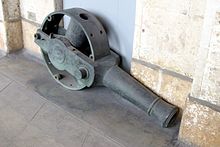Talk:Revolver cannon
| WikiProject Military history | (Rated Start-Class) | ||||||||||||||||||
|---|---|---|---|---|---|---|---|---|---|---|---|---|---|---|---|---|---|---|---|
| |||||||||||||||||||
Pictures[edit]
The pictures that have been added have little to do with the article. Neither of them depicts an autocannon. A picture of the BK-27 or Mauser MK 213 would be far more informative. Leibniz 12:34, 18 July 2006 (UTC)
Us version[edit]
:Switzerland produced the Oerlikon KCA, while the U.S. used the 20 mm version, re-chambered for a slightly larger 102 mm cartridge intermediate between the 213's 82 mm and Hispano-Suiza HS.404's 110 mm.
Does this refer to cartridge length?. It certainly doesn't refer to CalibrePetebutt (talk) 10:24, 31 October 2008 (UTC)
- That is correct - The US engineers re-chambered the cannon to ammunition with a slightly longer cartridge - 102 mm in length, which is in between the 213's original cartridge length of 82 mm, and the larger 110 mm long cartridge of the Hispano-Suiza HS.404. צנטוריון (talk) 12:42, 29 March 2009 (UTC)
Bad language and insults[edit]
You'd really best take a look at the last piece of this article, heavy vandalism. --Amendola90 (talk) 13:48, 14 February 2011 (UTC)
Bad language and insults[edit]
You'd really best take a look at the last piece of this article (this: Revolver_cannon#Characteristics) , heavy vandalism. --Amendola90 (talk) 13:49, 14 February 2011 (UTC)
- Looking at the history it seems to have been re-written from anothr time. --Amendola90 (talk) 13:54, 14 February 2011 (UTC)
introduction[edit]
I removed the second half of this sentence from the introductory paragraph:
- Automatic revolver cannons have been produced by many different European manufacturers, whereas the United States and to some extent Russia, generally favor the Rotary cannon.
 Revolver cannon[clarification needed]
Revolver cannon[clarification needed]
No reference was given for the comparative assertion. The generalization seems too broad, and blind to actual history. For example, the M39 revolver cannon was made in the United States, for decades, and used in at least five well known fighter planes.
- Zulu Kane (talk) 17:32, 8 May 2014 (UTC)
precursors[edit]
I deleted this mention of "Coffee Mill" gun, because it's not an example of nor precursor to revolver cannons:
- During the American Civil War, a different idea to a rotating set of chambers was the "Coffee Mill" Agar gun, in which the preloaded chambers were brought in front of the barrel, from a funnel similar in appearance to a Burr mill.[1]
BTW, it's also inaccurate to say "the preloaded chambers were brought in front of the barrel". (emphasis mine)
- Zulu Kane (talk) 23:22, 8 May 2014 (UTC)
References
- ^ Chinn, p. 185
Characteristics[edit]
What this article lacks is an explanation of how automatic revolver cannons operate. As a expedient (better than nothing) I've adapted this passage about revolver cannons, taken from the autocannon article:
- With a single barrel mated to a cylinder with multiple chambers, this type of autocannon uses the revolver principle to accelerate the cycle of loading, firing and ejecting multiple rounds of ammunition, achieving a very high rate of fire compared to conventional cannons of the same calibre.
I have avoided any comparison, here, to rotary cannon or gatling guns, because there's plenty of that in the subsection that follows.
I certainly invite someone with better knowledge of the subject to explain the actual mechanism. Or is the mechanism so very different between modern revolver cannons that they have nothing in common?
- Zulu Kane (talk) 00:37, 9 May 2014 (UTC)
Comparison to Gatling Cannons[edit]
This section of the article currently makes the following claim:
- "On the other hand, revolver cannon generally have a higher initial firing rate, due to the lower moving mass involved (only the chambers are being spun). Gatling type guns spin the whole multiple barrel and breech assembly, which in equal caliber versions can weigh hundreds of kilograms. Also, the external power source of US Gatling guns provides less power in a burst than the gas-operation of a revolver cannon[citation needed], requiring about half a second of spin-up time before the maximum rate of fire is reached."
Using the M61 Vulcan at 6,000 rounds per minute (100 rds/s), and the Mauser MG 213 at an average of 1300 rounds per minute (21 rds/s), we can easily see that not only is this claim false, it is completely backwards.
If we accept the 1/2 second spinup time for the M61 as correct (I cannot find this cited anywhere), the that means that during the first half-second of fire, the M61 outputs 25 rounds (50 rounds per half-second, average RoF during first half second == 25 rounds). However, during this same half second, the MG213 only fires 10 rounds, only two-fifths of what the Vulcan outputs.
Suggest editing to entirely remove these three sentences, as the overall claim is factually, and mathematically, incorrect. --ShuRugal (talk) 11:05, 4 May 2015 (UTC)ShuRugal
safety, motion[edit]
Compared to the rotary cannon, the revolver cannon seems more prone to self-destruction if a shell is even slightly fast or slow to be fired. Yes?
Does the revolver part spin smoothly, in discrete steps, or something in between?
97.104.70.92 (talk) 04:42, 22 September 2017 (UTC)

No comments:
Post a Comment